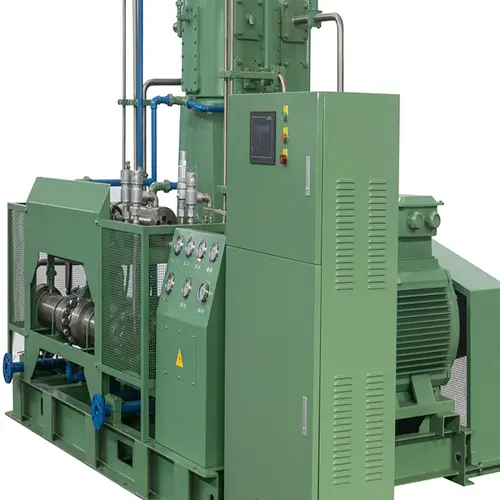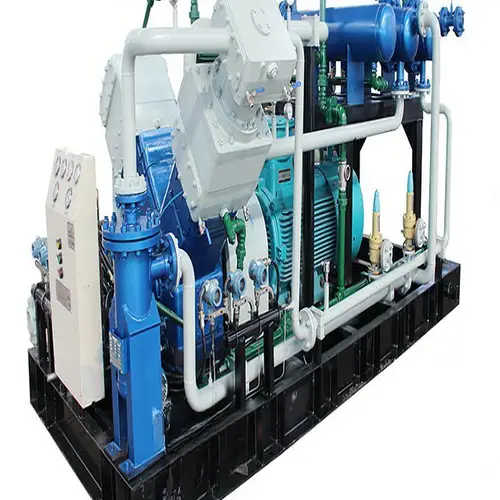 “`html
“`html
High Quality PSA Air Separation Unit and Oxygen Booster Compressor
Introducing our state-of-the-art PSA Air Separation Unit and Oxygen Booster Compressor, designed to meet the rigorous demands of various industries. This unit operates at a remarkable pressure of 150 bar, delivering an impressive flow rate of 100 Nm³/h for oxygen boosting applications. Our technology ensures efficient and reliable performance, making it an indispensable asset in your operational arsenal.
Applications of Oxygen Gas Compressors
Oxygen gas compressors serve pivotal roles across multiple sectors, enhancing productivity and safety. Here are the primary applications:
Filling Oxygen Cylinders
For the efficient filling of oxygen cylinders, our compressors operate in an entirely oil-free environment to maintain purity and pressure integrity. This ensures that the cylinders are filled to the required specifications without contamination.
Medical Oxygen Compression
In the medical field, oxygen compressors from PSA or liquid sources are compressed through one or two stages to pressures ranging from 3 barg (43 psig) to 20 barg (290 psig). Our units keep the oxygen pure, making it safe for direct patient use, and are designed for compactness, with power ratings typically between 3 to 15 kW.
Industrial Process Utilization
For broader industrial applications, our oxygen solutions accommodate higher volumes, reaching up to 3,000 Nm³/hr (1,900 SCFM). They can handle medium to low pressures, sometimes extending up to 35 barg (510 psig), serving industries such as steel mills, paper manufacturing, and water treatment facilities. These compressors are available in one, two, or three-stage designs, with power outputs ranging from 50 kW to 375 kW.
Technical Specifications of Oil-Free High Pressure Oxygen Booster Compressor
| Model | Intake Pressure (Mpa) | Exhaust Pressure (Mpa) | O2 Flow (Nm3/h) | Motor Power (KW) | Import Size | Export Size | Size (mm) | Weight (kg) | Rotating Speed (r/min) |
| GOW-5/4-(150/200) | 0.4 | 15 | 5 | 4.0 | Rc1/2 | G5/8 | 1350*850*1100 | 380 | 470 |
Explore Our Diverse Range of Industrial Products
In addition to our high-quality oxygen compressor solutions, our company specializes in a variety of industrial products, including agricultural gearboxes, power output shafts, sprockets, hydraulic couplings, worm gear reducers, racks, roller chains, pulleys, planetary gearboxes, timing pulleys, bushings, and more. We pride ourselves on offering preferential prices and attentive service, ensuring that our clients receive the best value. We welcome customization requests based on your drawings and samples.

Frequently Asked Questions
- What is the primary function of an oxygen gas compressor?
- How does the purity of medical oxygen get maintained during compression?
- What industries benefit most from high-pressure oxygen compressors?
- Can the oxygen compressors be customized based on specific requirements?
- What are the maintenance requirements for these compressors?
“`
Introduction to the Performance Characteristics of Oxygen Compressors
Oxygen compressors play a pivotal role in various industrial and medical applications by efficiently compressing oxygen gas to meet specific needs. Understanding their performance characteristics is crucial for selecting the right model for different applications. Below are key performance characteristics of oxygen compressors:
High Compression Ratio
Oxygen compressors are designed to achieve high compression ratios, which allows for the efficient conversion of low-pressure gas into high-pressure oxygen. This feature is essential for applications requiring high-pressure oxygen, such as medical uses in hospitals where portable oxygen supply is critical.
Energy Efficiency
Energy efficiency is a vital characteristic of oxygen compressors, as it directly impacts operational costs. Modern compressors utilize advanced technologies, such as variable speed drives and advanced cooling systems, to optimize energy consumption while maintaining high performance. This efficiency is especially important in industries where continuous operation is required.
Compact Design
The compact design of oxygen compressors allows for easy installation in confined spaces. This feature makes them ideal for both home medical use and industrial applications where space is a premium. Manufacturers have engineered designs that maximize output without compromising on size.
Durability and Reliability
Durability is a hallmark of quality oxygen compressors. Built with robust materials and components, these compressors are designed to withstand high operational stresses while ensuring reliability over long periods. This is particularly important in critical applications such as healthcare, where equipment failure can have serious consequences.
Noise and Vibration Levels
Reducing noise and vibration is a significant consideration in the design of oxygen compressors. Advanced engineering techniques and sound-dampening materials are employed to minimize operational noise, ensuring a quieter environment, especially in medical settings.
Types and Characteristics of Oxygen Compressors
Oxygen compressors come in various types, each suited to specific applications. Understanding these types and their characteristics can aid in selecting the most appropriate compressor for a given task.
Reciprocating Compressors
Reciprocating compressors utilize pistons to compress oxygen and are known for their high efficiency and reliability. They are commonly used in medical applications due to their ability to deliver high-pressure oxygen consistently.
Rotary Screw Compressors
Rotary screw compressors operate using two rotating screws to compress oxygen. They are favored in industrial applications for their high flow rates and continuous operation capabilities, making them suitable for large-scale operations.
Advantages of Different Materials Used in Oxygen Compressors
The materials used in manufacturing oxygen compressors significantly impact their performance and longevity.
Aluminum Compressors
Aluminum compressors are lightweight and resistant to corrosion, making them ideal for portable applications. Their strength-to-weight ratio facilitates easy handling and transportation.
Stainless Steel Compressors
Stainless steel compressors offer enhanced durability and resistance to wear and tear. They are suitable for high-pressure applications and environments where exposure to harsh conditions is anticipated.
Application of Oxygen Compressors in Various Industries
Oxygen compressors are integral to multiple sectors, reflecting their adaptability and importance.
Medical Industry
In the medical field, oxygen compressors are essential for supplying patients with necessary oxygen levels. They are used in hospitals, clinics, and home healthcare settings, ensuring that patients with respiratory issues receive adequate oxygen therapy.
Industrial Applications
Industries such as metal fabrication and chemical manufacturing utilize oxygen compressors for processes requiring high-purity oxygen. These compressors enhance productivity and efficiency in various industrial operations.
Aquaculture and Fisheries
Oxygen compressors are vital in aquaculture and fisheries, as they maintain optimal oxygen levels in water, promoting healthy growth conditions for aquatic life.
Aerospace Industry
In the aerospace sector, oxygen compressors play a crucial role in supplying breathable oxygen for high-altitude flights and space missions, ensuring the safety and comfort of crew members.
Petrochemical Industry
The petrochemical industry uses oxygen compressors in processes such as combustion and chemical reactions, enhancing efficiency and optimizing production yields.
Other Fields
Beyond these sectors, oxygen compressors are deployed in various fields, including environmental monitoring and waste management, emphasizing their versatility and utility.

Future Development Trends and Opportunities of Oxygen Compressors
As technology advances, the oxygen compressor industry is poised for significant growth and innovation. Emerging trends include the integration of smart technologies, which allow for real-time monitoring and maintenance, reducing downtime and operational costs.
Suggestions and Outlook
Industry professionals suggest continuous investment in research and development to enhance compressor efficiency and adaptability to changing market needs. The future may see a shift towards eco-friendly compressors that reduce carbon footprints, aligning with global sustainability goals.
Choosing a Suitable Oxygen Compressor
Selecting the right oxygen compressor involves several considerations, ensuring that the chosen model meets specific requirements.
Pressure Requirements
Understanding the pressure requirements for your application is crucial. Different industries may require varying levels of pressure, and choosing a compressor that meets these needs ensures optimal performance.
Flow Rate
The flow rate indicates how much oxygen the compressor can deliver in a given time frame. Assessing your operational needs will help determine the appropriate flow rate required for your applications.
Purity and Contamination Levels
In critical applications, the purity of oxygen is essential. Evaluating the compressor’s filtration systems and material compatibility can help ensure that the delivered oxygen meets necessary purity standards.
Energy Efficiency
Assessing the energy efficiency of oxygen compressors can yield significant cost savings over time. Selecting models that utilize cutting-edge technologies can help reduce energy consumption.
Noise and Vibration Levels
Lastly, considering noise and vibration levels will enhance comfort, especially in environments such as hospitals where quiet operation is crucial.
Conclusion
Oxygen compressors are indispensable tools across various industries, offering significant benefits in efficiency and performance. Understanding their characteristics, applications, and the factors to consider when choosing one is essential for maximizing their utility. As the industry evolves, ongoing advancements promise to enhance these vital systems even further.
All the content of the page is from the Internet, the content is only as a reference for product selection; our products are replacement parts and not original spare parts; we are not the holder of the original trademarks of the content; our products are only suitable for after-sales replacement parts and not original spare parts; our replacement parts can be perfectly adapted to the original spare parts; if you need to buy original spare parts, please contact the original factory to buy. If you want to buy original spare parts, please contact the original supplier for purchase.
Author: Dream
 “`html
“`html “`html
“`html

 “`html
“`html


